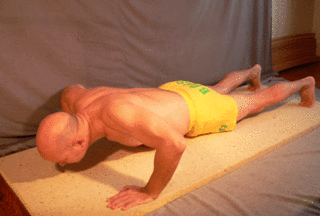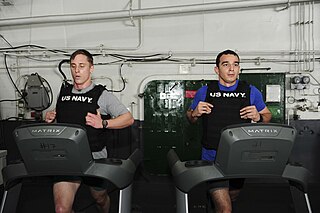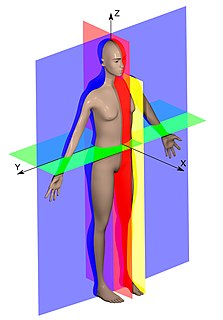
Calisthenics or callisthenics (/ˌkælɪsˈθɛnɪks/) is a form of strength training consisting of a variety of movements that exercise large muscle groups, such as standing, grasping, pushing, etc. These exercises are often performed rhythmically and with minimal equipment, as bodyweight exercises. They are intended to increase strength, fitness, and flexibility, through movements such as pulling, pushing, bending, jumping, or swinging, using one's body weight for resistance. Calisthenics can provide the benefits of muscular and aerobic conditioning, in addition to improving psychomotor skills such as balance, agility, and coordination. A study done in 2017 titled "The effects of a calisthenics training intervention on posture, strength and body composition" found that calisthenics training is an "effective training solution to improve posture, strength and body composition without the use of any major training equipment".

A push-up is a common calisthenics exercise beginning from the prone position. By raising and lowering the body using the arms, push-ups exercise the pectoral muscles, triceps, and anterior deltoids, with ancillary benefits to the rest of the deltoids, serratus anterior, coracobrachialis and the midsection as a whole. Push-ups are a basic exercise used in civilian athletic training or physical education and commonly in military physical training. They are also a common form of punishment used in the military, school sport, and some martial arts disciplines.

The sit-up is an abdominal endurance training exercise to strengthen, tighten and tone the abdominal muscles. It is similar to a crunch, but sit-ups have a fuller range of motion and condition additional muscles.

A squat is a strength exercise in which the trainee lowers their hips from a standing position and then stands back up. During the descent of a squat, the hip and knee joints flex while the ankle joint dorsiflexes; conversely the hip and knee joints extend and the ankle joint plantarflexes when standing up.

The crunch is one of the most popular abdominal exercises. When performed properly, it engages all the abdominal muscles but primarily it works the rectus abdominis muscle and the obliques. It allows both building six-pack abs, and tightening the belly. Crunches use the exerciser's own body weight to tone muscle, and are recommended as a low-cost exercise that can be performed at home.

The bridge is an exercise. Many variations of this exercise are employed throughout the world, most commonly the balancing of the body on the hands and the feet. It is intended to improve lower back and gluteus strength. Examples of bridging in sportive or self-defense applications are seen in Kung Fu, Judo, Brazilian jiu jitsu, Capoeira, mixed martial arts, and wrestling.

Lying triceps extensions, also known as skull crushers and French extensions or French presses, are a strength exercise used in many different forms of strength training. Lying triceps extensions are one of the most stimulating exercises to the entire triceps muscle group in the upper arm. It works the triceps from the elbow all the way to the latissimus dorsi. Due to its full use of the Triceps muscle group, the lying triceps extensions are used by many as part of their training regimen.

The kettlebell is a cast iron or cast steel ball with a handle attached to the top. It is used to perform many types of exercises, including ballistic exercises that combine cardiovascular, strength and flexibility training. They are also the primary equipment used in the weight lifting sport of kettlebell lifting.

Weighted clothing are garments that have heavy materials incorporated into them, to add weight to various parts of the body, usually as part of resistance training. The effect is achieved through attaching weighted pieces to the body which leave the hands free to grasp objects. Unlike with held weights or machines, weighted clothing can leave users more able to do a variety of movements and manual labour. In some cases certain weighted clothing can be worn under normal clothing, to disguise its use to allow exercise in casual environments.
Abdominal exercises are a type of strength exercise that affect the abdominal muscles. Human abdominal consist of four muscles which are the rectus abdomens, internal oblique, external oblique, and transversus abdominis. When performing abdominal exercises it is important to understand the effects, functions, the types of exercises, and think about how to perform this exercise safely.
A bent-over row is a weight training exercise that targets a variety of back muscles. Which ones are targeted varies on form. The bent over row is often used for both bodybuilding and powerlifting. It is a good exercise for increasing strength and size.

A fly or flye is a strength training exercise in which the hand and arm move through an arc while the elbow is kept at a constant angle. Flies are used to work the muscles of the upper body. Because these exercises use the arms as levers at their longest possible length, the amount of weight that can be moved is significantly less than equivalent press exercises for the same muscles . Due to this leverage, fly exercises of all types have a large potential to damage the shoulder joint and its associated ligaments and the tendons of the muscles connecting to it. They should be done with caution and their effects first tested while using very light weights; which are gradually incremented after more strength is gained.

The Roman chair is a piece of exercise equipment. The equipment is mainly used for the lower back, but can also target the gluteal muscles, hamstring and abdominals. The definition of the equipment, and what 'Roman chair exercise' specifically means, is not clear.
The Russian twist is a simple abdominal exercise for working the core, shoulders, and hips. It is typically performed in repetitive sets and tones the core muscles via a twisting motion focused around the abdomen. The exercise can help build strength in the upper torso, which may help in sports such as tennis, swimming, baseball, track & field, hockey, golf, lacrosse, or boxing. Additionally, there are many variations of the Russian twist that can be used to intensify a workout routine.

Hyperextension means a movement where extension is performed at any joint beyond its normal range of motion.
A power tower, also known as a knee raise station, and as a captain's chair, is a piece of exercise equipment that allows one to build upper body and abdominal muscle strength. When only the forearm pads alone are used for performing abdominal exercises, the power tower requires minimal arm strength as it is stable and movement occurs in the hips and torso. The equipment commonly has a backrest and forearm rests that form the chair, with vertical handles at the ends of the arm rests. The word "power" comes from the addition of other powerful arm exercises such as parallel horizontal handles for performing dips, a pull-up bar attached to the top for chin-ups and pull-ups, and push-up handles that are usually found on the bottom for Atlas ("deep") push-ups.

The leg raise is a strength training exercise which targets the iliopsoas. Because the abdominal muscles are used isometrically to stabilize the body during the motion, leg raises are also often used to strengthen the rectus abdominis muscle and the internal and external oblique muscles.
Surgical positioning is the practice of placing a patient in a particular physical position during surgery. The goal in selecting and adjusting a particular surgical position is to maintain the patient's safety while allowing access to the surgical site. Often a patient must be placed in an unnatural position to gain access to the surgical site.

Pelvic lift is an exercise to strengthen the lower back, glute muscles, lower abdominal muscles, and maintain hip muscle balance. It does not require weights, although they can be placed on the stomach.














